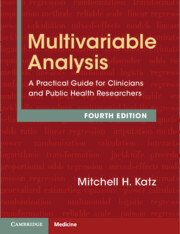Book contents
- Multivariable Analysis
- Multivariable Analysis
- Copyright page
- Contents
- Preface
- 1 Introduction
- 2 Common Uses of Multivariable Models
- 3 Outcome Variables in Multivariable Analysis
- 4 Independent Variables in Multivariable Analysis
- 5 Relationship of Independent Variables to One Another
- 6 Setting Up a Multivariable Analysis
- 7 Performing the Analysis
- 8 Interpreting the Results
- 9 Delving Deeper: Checking the Underlying Assumptions of the Analysis
- 10 Propensity Scores
- 11 Correlated Observations
- 12 Sensitivity Analysis
- 13 Validation of Models
- 14 Special Topics
- 15 Publishing Your Study
- 16 Summary: Steps for Constructing a Multivariable Model
- Index
14 - Special Topics
Published online by Cambridge University Press: 09 October 2025
- Multivariable Analysis
- Multivariable Analysis
- Copyright page
- Contents
- Preface
- 1 Introduction
- 2 Common Uses of Multivariable Models
- 3 Outcome Variables in Multivariable Analysis
- 4 Independent Variables in Multivariable Analysis
- 5 Relationship of Independent Variables to One Another
- 6 Setting Up a Multivariable Analysis
- 7 Performing the Analysis
- 8 Interpreting the Results
- 9 Delving Deeper: Checking the Underlying Assumptions of the Analysis
- 10 Propensity Scores
- 11 Correlated Observations
- 12 Sensitivity Analysis
- 13 Validation of Models
- 14 Special Topics
- 15 Publishing Your Study
- 16 Summary: Steps for Constructing a Multivariable Model
- Index
Summary
An emulation (or target) trial uses observational data to simulate a trial. Because there is no actual randomization, multivariable methods need to adjust for differences between groups. However, emulation trials improve traditional observational studies by conducting all the same steps as a randomized trial with the exception of randomization. With an emulation trial, before conducting data analysis, specify research question eligibility criteria, determination of treatment groups, start of study and end of follow-up, outcome, and analysis plan. Active comparators can minimize indication bias. By setting eligibility, treatment assignment, and start of follow-up, emulation trials minimize immortal time bias.
Classification and regression trees (CART): a technique for separating subjects into distinct subgroups based on a dichotomous outcome. Its major advantage over multiple logistic regression—it more closely reflects how clinicians make decisions. Certain pieces of information take you down a particular diagnostic path for more information to prove/disprove you are on the right path. Most clinicians do not total up a weighted version of the information and make a decision.
Keywords
Information
- Type
- Chapter
- Information
- Multivariable AnalysisA Practical Guide for Clinicians and Public Health Researchers, pp. 244 - 252Publisher: Cambridge University PressPrint publication year: 2025
Accessibility standard: Inaccessible, or known limited accessibility
Why this information is here
This section outlines the accessibility features of this content - including support for screen readers, full keyboard navigation and high-contrast display options. This may not be relevant for you.Accessibility Information
Content Navigation
Allows you to navigate directly to chapters, sections, or non‐text items through a linked table of contents, reducing the need for extensive scrolling.
Provides an interactive index, letting you go straight to where a term or subject appears in the text without manual searching.
Reading Order & Textual Equivalents
You will encounter all content (including footnotes, captions, etc.) in a clear, sequential flow, making it easier to follow with assistive tools like screen readers.
You get more than just short alt text: you have comprehensive text equivalents, transcripts, captions, or audio descriptions for substantial non‐text content, which is especially helpful for complex visuals or multimedia.
You can access graphs or charts in a text or tabular format, so you are not excluded if you cannot process visual displays.
Visual Accessibility
You will still understand key ideas or prompts without relying solely on colour, which is especially helpful if you have colour vision deficiencies.
You benefit from high‐contrast text, which improves legibility if you have low vision or if you are reading in less‐than‐ideal lighting conditions.
